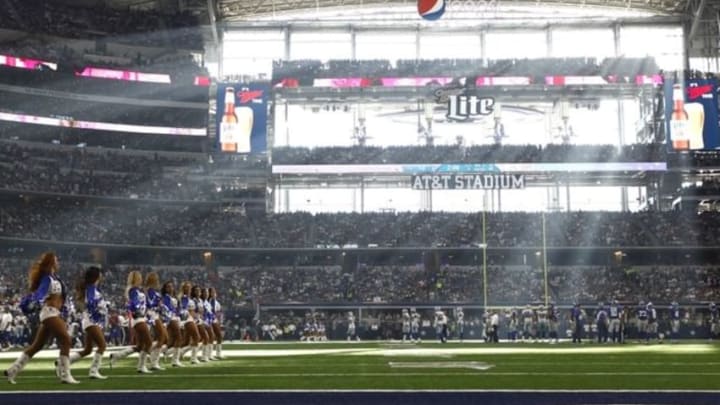Dallas Cowboys Away Games Are Their Home Games

If the Dallas Cowboys record proves anything the last two years, it’s the fact their away games are their home games when it comes home field advantage.
Ever since AT&T Stadium opened in 2009 as the new home for the Dallas Cowboys, replacing the legendary Texas Stadium, there has been a stigma attached to the massive arena. In fact, most would say it started in Week Two of the NFL regular season that year. It’s the fear that AT&T Stadium, for whatever reason, is no home field advantage for the Cowboys.
The catalyst for this fear started after the New York Giants defeated Dallas in the Stadium’s opening game 33-31 on September 20, 2009. After the defeat, Giants quarterback Eli Manning signed the locker room with the phrase “First win in the new stadium” along with his autograph. For many, that’s when the curse began.
Stadiums across the NFL are known for their distinct home field advantage. Meccas of football like the Denver Broncos’ Sports Authority Field at Mile High, the Seattle Seahawks’ CenturyLink Field or the Kansas City Chiefs’ Arrowhead Stadium. But AT&T Stadium is never mention among them. And it’s the arena’s atmosphere combined with the Cowboys poor home record that is likely the reasons why.
Many describe the atmosphere in AT&T Stadium during a game to be a bit more laissez faire than others. Where most stadiums are known for their ravenous and loud fan bases whose cheering disrupts opposing teams, the crowd in Arlington appears more posh and reserved. Although there is an portion of the fan base that can be heard on most plays, they are often drowned out by the spectacle of the stadium itself and the opposing team’s fans.
The latter being a big issue, as Cowboys season-ticket holders all to often sell their seats to fans of the opposing team. In some instances in such large quantities that they seem much louder and better represented than the home fans themselves. This is especially true in a down year in Dallas.
Another distracting issue that could be costing the Cowboys a distinct lack of home field advantage is the massive video screen that stretches nearly the length of the football field directly above it. Many describe it as being far too big and too distracting from the actual game. instead of watching the contest being played out on the field itself, the crowd, the coaches and the players often watch the action on the screen above as if they were on their collective couch in their living room.
Finally, let’s consider the Cowboys home record since the Stadium opened in 2009.
Dallas Cowboys Home/Away Records (including playoffs)
More from The Landry Hat
- 3 ways Cowboys’ Dak Prescott can have a bounce-back season in 2023
- Cowboys News: Dallas sets pre-draft visit with potential Dalton Schultz upgrade
- NFL executives heaping praise on offseason is uncharted territory for Cowboys
- 3 free agent signings from NFC East rivals that left Cowboys fans laughing
- Cowboys News: Brandin Cooks sends flattering message to CeeDee Lamb, Stephon Gilmore
Home 2009: 7-2
Away 2009: 5-4
Home 2010: 2-6
Away 2010: 4-4
Home 2011: 5-3
Away 2011: 3-5
Home 2012: 4-4
Away 2012: 4-4
Home 2013: 5-3
Away 2013: 3-5
Home 2014: 5-4
Away 2014: 8-1
Home 2015: 1-7
Away 2015: 3-5
Home 2016: 0-1
Since 2009, the Cowboys have a combined home record of 29-30. Their away record during that same span is 30-29. According to the numbers, Dallas plays better on the road than in AT&T Stadium. Especially when you consider the past two years. In 2014, the Cowboys were undefeated on the road during the regular season. Last year, three out of Dallas’ four total victories were away games.
Next: Dallas Cowboys keys to victory vs Washington Redskins
As the most popular team in the NFL, the Dallas Cowboys are a big draw at every away game. So much so, the Dallas contingent sometimes seem to outnumber the home team’s fans. (sound familiar?) For the Cowboys, at least for the past couple seasons anyway, their away games have become their home games. Let’s see if that trend continues in 2016.